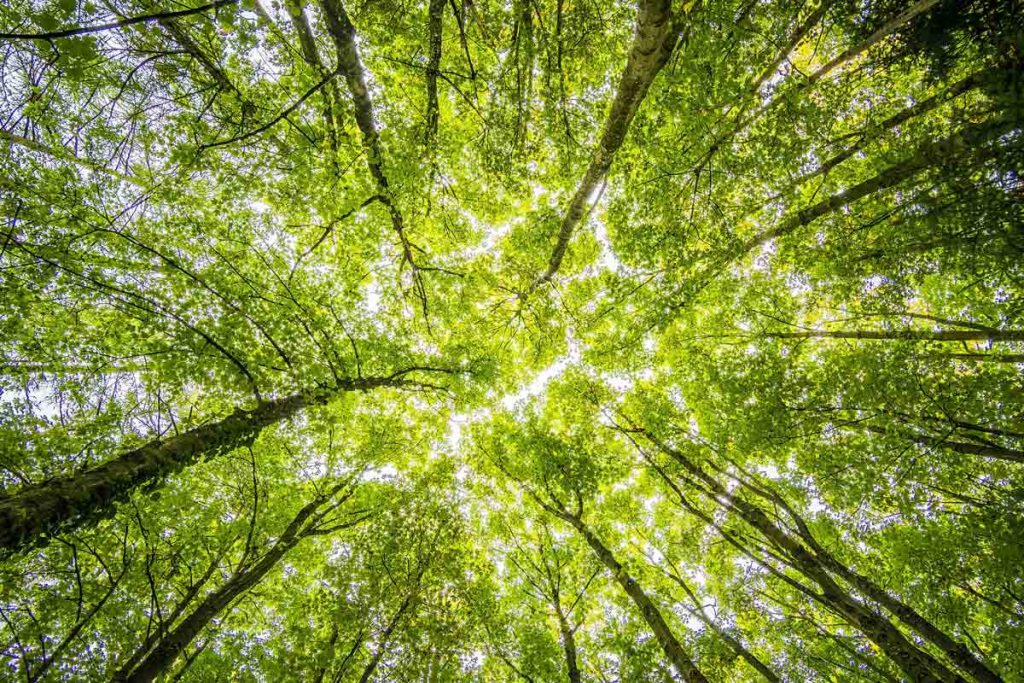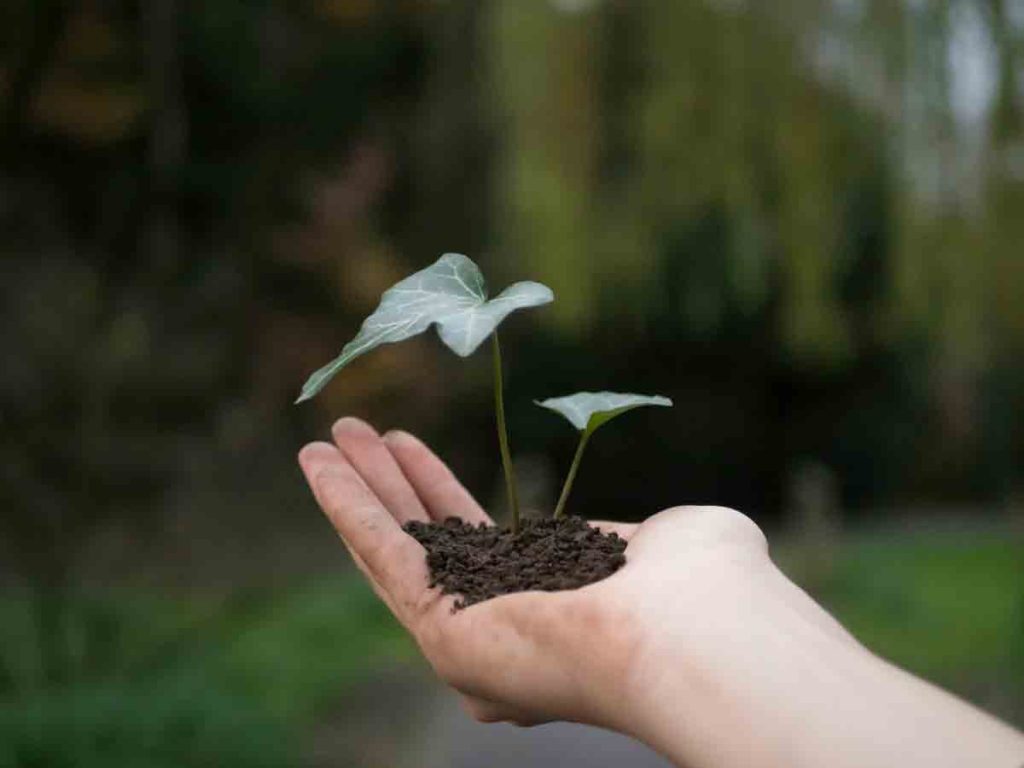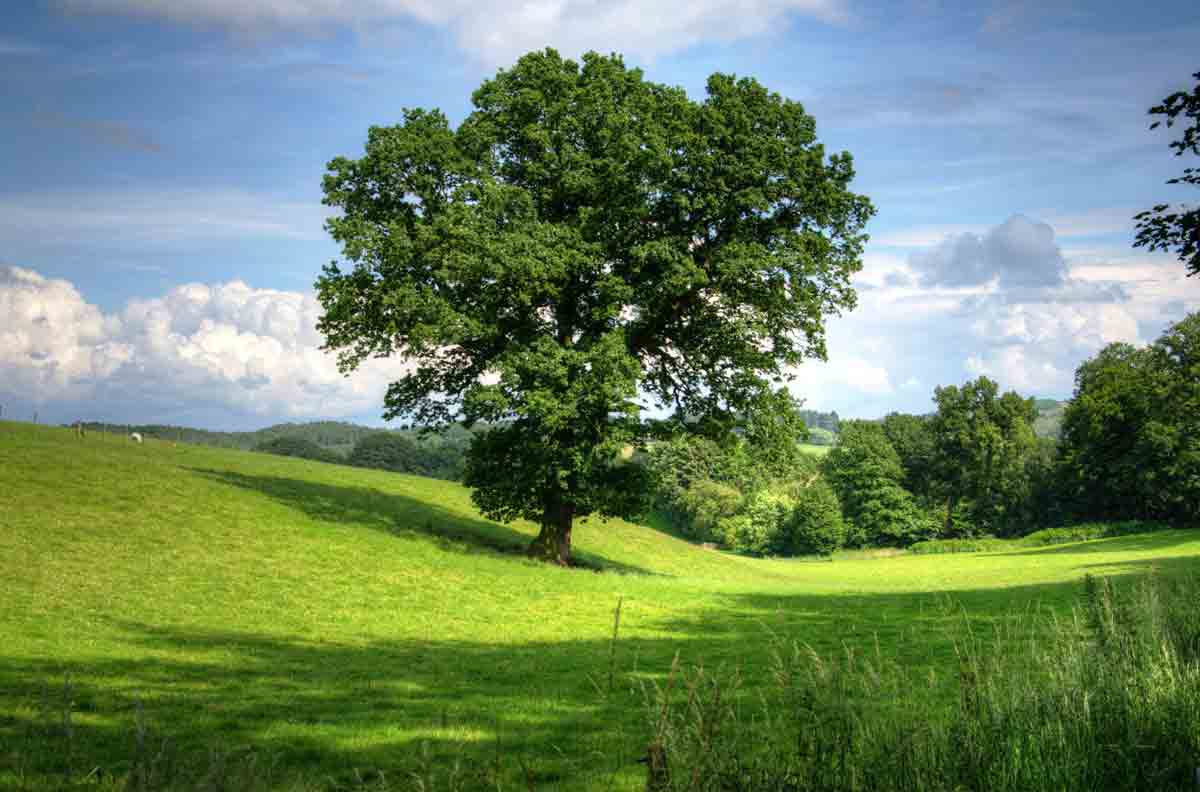Paragraph On Importance Of Trees
In a bustling world dominated by technology and urbanization, the silent giants that stand tall in our forests often go unnoticed. Trees, with their graceful branches and steadfast roots, are not just mere adornments of nature’s beauty but essential pillars of life on Earth. From providing oxygen for us to breathe to offering shelter to countless creatures, trees play a vital role in maintaining the delicate balance of our ecosystem.
As we navigate through our busy lives, it is easy to overlook the significance of these green guardians who silently watch over us.
It’s time to read the paragraph on importance of trees and understand why they are not just a part of nature’s scenery.
| Information | Oxygen Produced |
|---|---|
| A big, leafy tree. | Makes as much oxygen in a season as 10 people breathe in a year. |
| A tall tree that’s 100 feet high and 18 inches wide. | Makes 6,000 pounds of oxygen. |
| On average, one tree. | Makes about 260 pounds of oxygen each year. |
Paragraph On Importance Of Trees 100 Words
Trees are super important! They help us in so many ways. First off, they give us fresh air to breathe. When we breathe in, trees take in the yucky carbon dioxide we breathe out and give us back nice, clean oxygen. Plus, trees are homes for lots of animals like birds, squirrels, and insects. They provide shade on hot days and help keep the soil healthy. We can also make things like paper and furniture from trees. But here’s the important part: we need to take care of trees! We should plant new ones and make sure not to cut down too many. That way, we can keep enjoying all the awesome things trees do for us.
Paragraph On Importance Of Trees 150 Words
Trees play a crucial role in sustaining life on Earth, offering a multitude of benefits that are vital for both the environment and human well-being.
Firstly, trees act as natural carbon sinks, absorbing greenhouse gases that contribute to climate change, thus playing a pivotal role in mitigating its effects.
Secondly, the presence of trees has been linked to improved mental health and enhanced physical well-being, as they provide spaces for relaxation and recreation, and their presence in urban areas helps reduce stress and anxiety.
Moreover, trees play a significant role in purifying the air by filtering out pollutants and releasing oxygen, thus ensuring a healthier environment for all living beings. Additionally, trees serve as habitats for diverse wildlife, providing shelter and food sources essential for their survival. Furthermore, trees play a critical role in maintaining clean water sources by filtering and regulating water flow, thereby ensuring a more reliable drinking supply for communities.
In essence, the importance of trees cannot be overstated, as they contribute immensely to the health of our planet and the well-being of all its inhabitants.
Importance Of Trees Paragraph 200 Words
In the symphony of life, trees compose the grandest movements, harmonizing with the rhythm of nature itself. Their significance transcends mere aesthetics; they are the silent guardians of our planet, purifying the air we breathe, anchoring soil against erosion, and offering sanctuary to countless species.
Planting trees is akin to sowing hope for the future. Each sapling represents a promise of resilience against climate change, a pledge to combat deforestation, and an investment in sustainable ecosystems. Like benevolent sentinels, trees stand tall, bearing witness to the passage of time and the evolution of our world.
Beyond their ecological importance, trees foster community. They provide shade for gatherings, avenues for exploration, and spaces for contemplation. Under their boughs, friendships blossom, memories are made, and stories are shared, weaving a tapestry of connection between people and nature.
Moreover, trees hold cultural and spiritual significance across civilizations, embodying strength, wisdom, and renewal. They inspire artists, poets, and philosophers, serving as muses and metaphors in our collective consciousness.
In essence, the act of planting a tree is an affirmation of our commitment to the planet and each other. It is a gesture of gratitude to the earth that sustains us and a testament to our responsibility as stewards of its abundance. As we nurture these silent giants, we nurture our humanity, fostering a legacy of sustainability, beauty, and interconnectedness for generations to come.
Importance Of Trees Paragraph 300 Words
Trees are indispensable pillars of our environment, playing multifaceted roles that are crucial for sustaining life on Earth. Their significance spans ecological, social, economic, and even psychological dimensions.
Ecologically, trees are the lungs of our planet, absorbing carbon dioxide and releasing oxygen through the process of photosynthesis, thereby regulating the composition of our atmosphere and mitigating the impacts of climate change. They serve as habitats for countless species of flora and fauna, fostering biodiversity and ecological balance.
Moreover, trees help to prevent soil erosion, regulate water cycles, and purify the air by filtering out pollutants. On a social level, trees contribute to the aesthetic beauty of landscapes, enhancing the quality of life in urban and rural areas alike. They provide shade and shelter, creating comfortable microclimates that encourage outdoor activities and promote physical and mental well-being.
Economically, trees are valuable renewable resources that support industries such as forestry, agriculture, and tourism, generating income and employment opportunities for millions of people worldwide. Timber, fruits, nuts, and medicinal products derived from trees constitute essential components of various sectors of the economy. Furthermore, trees contribute to the resilience of communities by acting as natural buffers against natural disasters like floods, storms, and landslides.
In addition to their tangible benefits, trees hold significant cultural and spiritual importance for many societies, symbolizing longevity, strength, and vitality across diverse cultural traditions. They feature prominently in religious rituals, folklore, and literature, embodying connections to ancestral heritage and the rhythms of nature.
In essence, the importance of trees transcends mere utility, embodying a profound symbiosis between humanity and the natural world, upon which our collective well-being ultimately depends. Thus, the preservation and responsible stewardship of trees is imperative for the preservation of life on Earth and the sustainability of future generations.
A Long and Useful Paragraph on the Importance Of Trees for Kids-Class2/ Class 3-7 500 Words
In today’s world, where environmental issues are at the forefront of global concern, the significance of trees cannot be overstated. Trees are not merely silent spectators in the landscape; they are vital components of our ecosystem, offering an array of benefits that touch nearly every aspect of human life.
First and foremost, trees play a crucial role in preventing soil erosion. Their extensive root systems anchor the soil in place, reducing the risk of erosion caused by wind and water. This helps to maintain the integrity of our landscapes and prevents the loss of fertile soil.
Additionally, trees cool the air by providing shade and releasing water vapor through a process called transpiration. This natural cooling effect is especially important in urban areas, where the heat island effect can lead to dangerously high temperatures. By mitigating this effect, trees contribute to the overall comfort and well-being of urban residents.
Moreover, research has shown that areas with more trees tend to have lower rates of violent crime. The presence of green spaces, including trees, has a calming effect on individuals and fosters a sense of community, ultimately reducing the likelihood of violent behavior.
Beyond their immediate surroundings, trees also offer valuable insights into larger environmental trends. Tree rings, for example, can provide clues about past climates and help scientists predict future changes. By studying tree growth patterns, researchers can better understand the complex dynamics of our planet’s climate system.
On a more personal level, trees have a profound impact on human health and well-being. Spending time in nature, surrounded by trees, has been shown to reduce stress and improve mental health. The Japanese practice of shinrin-yoku, or forest bathing, is based on the idea that immersing oneself in a forest environment can have therapeutic effects.
Even in death, trees continue to serve important purposes. Dead trees provide habitat and food for countless organisms, contributing to the biodiversity of forest ecosystems.
Furthermore, trees attract wildlife, providing essential habitat and food sources for birds, mammals, insects, and other species. By supporting diverse ecosystems, trees help to maintain the balance of nature and ensure the health of our planet.
In addition to their ecological benefits, trees also play a critical role in improving air and water quality. Through photosynthesis, trees absorb carbon dioxide and other pollutants from the atmosphere, helping to mitigate climate change and reduce air pollution. Their root systems also help to filter and purify water, improving water quality for both humans and wildlife.
Furthermore, trees are a source of medicine, providing ingredients for countless pharmaceuticals and herbal remedies. From aspirin to Taxol, many of the drugs we rely on today are derived from compounds found in trees.
Of course, one of the most well-known benefits of trees is their production of oxygen. Through photosynthesis, trees convert carbon dioxide into oxygen, providing the very air we breathe.
In addition to their practical benefits, trees also enhance the aesthetic value of our surroundings. Their majestic beauty and seasonal changes bring joy and inspiration to people around the world.
In conclusion, trees are truly remarkable organisms that enrich our lives in countless ways. From preventing soil erosion to improving air quality, from providing habitat for wildlife to offering therapeutic benefits for humans, the importance of trees cannot be overstated. As stewards of the planet, it is our responsibility to protect and preserve these invaluable resources for future generations.
Word Meaning
| Word | Meaning |
|---|---|
| Trees | Tall, woody perennial plants typically with a single trunk, branches, and leaves; crucial for sustaining life |
| Importance | Significance, relevance, the quality of being essential or impactful |
| Oxygen | A colorless, odorless gas essential for respiration, produced by trees during photosynthesis |
| Carbon dioxide | A colorless, odorless gas produced by human activities and absorbed by trees during photosynthesis |
| Habitat | Natural environment or home of an organism, provided by trees for various wildlife species |
| Shade | Shelter from direct sunlight provided by trees, essential for cooling and comfort on hot days |
| Soil | The process by which water is drawn up from the roots of trees and released as vapor through their leaves |
| Ecosystem | A biological community of interacting organisms and their physical environment, sustained by trees |
| Photosynthesis | The process by which green plants and some other organisms use sunlight to synthesize food from carbon dioxide and water |
| Biodiversity | The variety and variability of life forms in a given ecosystem, supported and enhanced by trees |
| Transpiration | The process of urban development and expansion, countered by trees to mitigate the urban heat island effect |
| Climate change | Long-term alteration in global or regional climate patterns, mitigated by trees through carbon sequestration |
| Mental health | Emotional, psychological, and social well-being, improved by exposure to green spaces and trees |
| Urbanization | The process of urban development and expansion, countered by trees to mitigate urban heat island effect |
| Conservation | The protection, preservation, and sustainable use of natural resources, including trees |
| Erosion | The process of wearing away of land or soil by wind, water, or other natural agents, prevented by trees |
| Pollutants | Harmful substances introduced into the environment, filtered out by trees through air and water purification |
| Renewable resources | Natural resources that can be replenished over time, including trees used for various purposes |
| Ecosystem services | Benefits provided by ecosystems to humans, such as clean air, water, and biodiversity, supported by trees |
| Stewardship | Responsible management and care of resources, including trees, for the benefit of present and future generations |
| Sustainability | The ability to meet present needs without compromising the ability of future generations to meet their own needs, upheld by responsible tree management |
Benefits and Importance of Planting Trees
Trees play a crucial role in maintaining the health of our planet and supporting life in numerous ways. So what are the 10 importance of trees? Here are the important benefits of trees and why tree planting is essential:

- Oxygen Production: Trees absorb carbon dioxide and release oxygen through the process of photosynthesis, providing the oxygen we need to breathe.
- Carbon Sequestration: Trees act as carbon sinks, absorbing carbon dioxide from the atmosphere and storing it in their biomass and soil, thereby helping to mitigate climate change by reducing the concentration of greenhouse gases in the atmosphere.
- Climate Regulation: Trees play a critical role in regulating local and global climates by moderating temperature extremes, providing shade, and reducing the impact of heat waves and urban heat islands.
- Biodiversity Support: Trees provide habitats and food sources for a diverse array of plant and animal species, contributing to biodiversity conservation and ecosystem stability.
- Soil Protection: The roots of trees help to stabilize soil, prevent erosion, and reduce the risk of landslides, while also improving soil fertility through the deposition of organic matter and the facilitation of nutrient cycling.
- Water Management: Trees help to regulate the water cycle by intercepting rainfall, reducing runoff, and promoting groundwater recharge, which is crucial for maintaining freshwater availability and preventing floods and droughts.
- Air Quality Improvement: Trees filter pollutants from the air, including particulate matter, ozone, nitrogen dioxide, and sulfur dioxide, thereby improving air quality and reducing the risk of respiratory diseases.
- Aesthetic and Recreational Value: Trees enhance the beauty of landscapes, provide shade and shelter for outdoor activities, and create peaceful and inviting environments for relaxation and recreation.
- Economic Benefits: Trees contribute to the economy through various means, including the provision of timber, fruits, nuts, and other forest products, as well as the support of industries such as forestry, agriculture, tourism, and recreation.
- Health and Well-being: Numerous studies have shown that exposure to trees and green spaces has positive effects on mental and physical health, reducing stress, improving mood, enhancing cognitive function, and promoting overall well-being.
Given these myriad benefits, tree planting is essential for preserving and restoring ecosystems, combating climate change, protecting biodiversity, ensuring sustainable development, and promoting human health and prosperity. It is a simple yet powerful act that individuals, communities, governments, and organizations can undertake to contribute to a healthier and more sustainable future for generations to come.
Air Purifying Trees
| Tree/Plant | Description |
|---|---|
| Spider Plant | Effective at removing formaldehyde and xylene from indoor air. |
| Weeping Fig | Known for its air-purifying qualities, particularly in removing formaldehyde. |
| Peace Lily | Excellent at eliminating airborne toxins such as ammonia, benzene, and formaldehyde. |
| Aloe Vera | Cleanses the air of formaldehyde and benzene, commonly found in household cleaners and paints. |
| Rubber Plant | Removes toxins like formaldehyde and carbon monoxide from the air. |
| Snake Plant | Absorbs toxins and releases oxygen during the night, making it ideal for bedrooms. |
| Spathiphyllum | Helps to eliminate airborne toxins such as ammonia, benzene, and formaldehyde. |
| Chamaedorea seifrizii | Effective at removing indoor air pollutants and requires low maintenance. |
| Sword Fern | Known for its ability to remove pollutants like formaldehyde and xylene. |
| Dragon Tree | Removes pollutants like benzene, formaldehyde, trichloroethylene, and xylene. |
| Philodendron | Helps to purify the air by removing formaldehyde. |
| Areca Palm | Removes harmful toxins like formaldehyde and xylene from indoor air. |
| Aglaonema | Effective at removing indoor air pollutants and easy to care for. |
| Chrysanthemum | Known for its ability to remove benzene from indoor air. |
| Janet Craig | Removes toxins like formaldehyde and benzene from indoor air. |
| Dracaena | Comes in various varieties, all effective at removing pollutants like benzene, formaldehyde, trichloroethylene, and xylene. |
| Gerbera Daisy | Excellent at removing toxins like benzene and formaldehyde from indoor air. |
| Pothos | Removes pollutants like formaldehyde from indoor air. |
| Cornstalk Dracaena | Known for its air-purifying qualities and ease of care. |
| Dwarf Date Palm | Helps to purify indoor air by removing toxins like formaldehyde. |
| Lady Palm | Effective at removing indoor air pollutants and requires little maintenance. |
| Barberton Daisy | Known for its ability to remove toxins like formaldehyde from indoor air. |
| Ficus | Effective at removing pollutants like formaldehyde from indoor air. |
| Nephrolepis Obliterata | Helps to improve indoor air quality by removing pollutants. |
Types of Tress
| Tree Name | Description |
|---|---|
| Oak | Evergreen trees are cultivated for their fruit, olives, and oil. |
| Willow | Deciduous tree with long, slender branches. |
| Coconut | Tropical palm trees produce large, edible fruits. |
| Olive | A large, iconic tree native to Africa known for its swollen trunk and longevity. |
| Ginkgo | Deciduous tree with distinct fan-shaped leaves. |
| Baobab | An evergreen tree whose leaves are used as a culinary herb. |
| Magnolia | Ornamental tree with large, fragrant flowers. |
| American Sycamore | Large deciduous tree with distinctive mottled bark. |
| Almond | Deciduous tree cultivated for its nuts. |
| Bay Laurel | Evergreen trees with various medicinal properties. |
| Neem Tree | Deciduous trees are known for their hard and durable wood. |
| Black Locust | The massive evergreen tree is known for being among the largest and oldest living organisms. |
| Sycamore Maple | Deciduous tree with distinctive lobed leaves. |
| Walnut Tree | The evergreen coniferous tree known for its aromatic resin. |
| Giant Sequoia | The deciduous tree produces edible nuts. |
| Pistachio | The deciduous tree produces edible nuts. |
| Papaya | Tropical fruit tree with large, elongated fruits. |
| Cacao Tree | Tree cultivated for its seeds, which are used to make chocolate. |
| Pará Rubber Tree | The tree is known for its latex production, used in rubber manufacturing. |
| Pecan | A tall evergreen tree native to Australia. |
| Tasmanian Blue Gum | The deciduous tree produces edible nuts. |
| Rubber Fig | Evergreen tree with large, glossy leaves. |
| Balsam Fir | Evergreen trees are valued for their aromatic wood and essential oil. |
| European Ash | Deciduous tree native to Europe. |
| Camphor Tree | A tall evergreen tree native to the Pacific coast of North America. |
| Banyan | The fig tree is known for its aerial roots that grow into new trunks. |
| Dragon Tree | Evergreen tree with a distinctive umbrella-shaped canopy. |
| Coast Redwood | Large tree-producing edible nuts enclosed in hard shells. |
| Blue Spruce | Evergreen coniferous tree with striking blue-green foliage. |
| European Beech | Deciduous tree native to Europe. |
| Breadfruit | Tropical trees produce large, starchy fruits. |
| Silver Birch | Deciduous tree with distinctive white bark. |
| Clove | Evergreen tree cultivated for its aromatic flower buds. |
| Brazil Nut | A tree whose bark is used to produce cinnamon spice. |
| English Oak | Deciduous tree native to Europe. |
| Tea Plant | Evergreen shrub/tree cultivated for its leaves, used to make tea. |
| True Cinnamon Tree | A small evergreen tree whose leaves are used as a spice in Indian cuisine. |
| Indian Gooseberry | Small tree-bearing sour fruit is used in various culinary and medicinal applications. |
| Curry Tree | A tall evergreen coniferous tree native to eastern North America. |
| Eastern White Pine | An evergreen oak tree native to the Mediterranean region, known for its cork bark. |
| Quercus Suber | A coniferous tree native to Europe, known as the European silver fir. |
| Nutmeg | Tropical evergreen tree producing the spice nutmeg. |
| Abies Alba | Deciduous trees native to North America, are often found near water bodies. |
| Sugar Maple | Deciduous tree known for its vibrant autumn foliage and sap used in syrup production. |
| Honey Locust | Deciduous tree with thorny branches and clusters of fragrant flowers. |
| African Oil Palm | Tropical palm tree cultivated for its oil-rich fruit. |
| Tilia Cordata | A coniferous tree native to eastern North America, valued for its ornamental qualities. |
| Eastern Cottonwood | The deciduous tree is commonly known as the small-leaved lime or little-leaf linden. |
| Silver Maple | The deciduous tree is known for its rapid growth and silver-gray bark. |
| Eastern Hemlock | The evergreen coniferous tree is known for its aromatic resin. |

Tree Cutting Disadvantages
Tree cutting, while sometimes necessary for various reasons, comes with several disadvantages, including:
- Loss of Biodiversity: Trees provide habitats for numerous species of plants and animals. Cutting down trees can disrupt ecosystems, leading to a loss of biodiversity.
- Soil Erosion: Tree roots help bind soil together, preventing erosion. When trees are cut down, soil erosion can occur, leading to land degradation and loss of fertility.
- Impact on Climate: Trees play a crucial role in regulating climate by absorbing carbon dioxide and releasing oxygen through photosynthesis. Cutting down trees contributes to increased levels of carbon dioxide in the atmosphere, which can exacerbate climate change.
- Loss of Oxygen: Trees produce oxygen as a byproduct of photosynthesis. Fewer trees mean less oxygen production, potentially affecting air quality and human health.
- Impact on Water Cycle: Trees play a significant role in the water cycle by absorbing water from the soil and releasing it into the atmosphere through transpiration. Deforestation can disrupt this cycle, leading to changes in precipitation patterns and water availability.
- Loss of Aesthetic Value: Trees enhance the beauty of landscapes and provide shade in urban areas. Cutting down trees can diminish the aesthetic appeal of an area and reduce shade, leading to increased temperatures in urban environments.
- Disruption of Indigenous Communities: Many indigenous communities rely on forests for their livelihoods, cultural practices, and spiritual beliefs. Deforestation can disrupt these communities’ way of life and lead to social and economic hardships.
- Increased Risk of Natural Disasters: Trees act as natural barriers against floods, landslides, and other natural disasters. Deforestation can increase the risk of such events by removing this natural protection.
- Loss of Medicinal Resources: Many trees and plants have medicinal properties that are used in traditional medicine practices. Cutting down trees can lead to a loss of these valuable resources.
- Economic Impact: While there may be short-term economic benefits to tree cutting, such as timber production, the long-term costs associated with environmental degradation, loss of ecosystem services, and impacts on industries like tourism and agriculture can outweigh these benefits.
Overall, while tree cutting may be necessary for certain purposes such as urban development or timber production, it should be carefully managed to minimize its negative impacts on the environment, biodiversity, and human well-being. Sustainable forestry practices and reforestation efforts are essential to mitigate these disadvantages.
Tree Cutting Disasters
| Disasters | Description |
|---|---|
| Deforestation | Deforestation reduces the ability of forests to absorb and regulate water, increasing the risk of flooding during heavy rainfall events, impacting communities downstream, and causing infrastructure damage. |
| Landslides | Removal of trees destabilizes soil and increases the risk of landslides, particularly in hilly or mountainous regions, causing property damage, loss of life, and disruption of ecosystems. |
| Flooding | Without tree roots to bind the soil together, erosion rates increase, leading to loss of fertile topsoil, reduced agricultural productivity, and sedimentation in waterways. |
| Soil Erosion | Without tree roots to bind soil together, erosion rates increase, leading to loss of fertile topsoil, reduced agricultural productivity, and sedimentation in waterways. |
| Habitat Loss | Removal of trees destroys habitats for numerous plant and animal species, leading to species extinction, disrupted ecosystems, and loss of ecological services. |
| Climate Change | Deforestation contributes to climate change by releasing stored carbon dioxide into the atmosphere, disrupting weather patterns, and altering regional climates. |
| Wildfires | Removal of trees can increase the risk and severity of wildfires by creating drier conditions and reducing natural fire barriers, leading to property damage, loss of life, and environmental destruction. |
| Loss of Indigenous Rights | Deforestation often occurs on lands inhabited by indigenous communities, leading to displacement, loss of traditional livelihoods, and infringement on indigenous rights and cultural heritage. |
Conclusion
This importance of trees paragraph teaches us that trees are vital to the health of our planet and play a crucial role in maintaining ecological balance. They provide oxygen, absorb harmful greenhouse gases, and support diverse ecosystems that sustain countless species of plants and animals. Trees also help in reducing air pollution, preventing soil erosion, and providing shade and shelter for wildlife.
We must recognize the significance of trees and take proactive steps to protect and preserve them for future generations. Let us all commit to planting more trees, supporting reforestation efforts, and advocating for sustainable practices to ensure a greener and healthier world for all.







